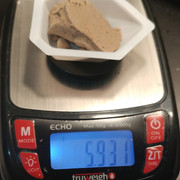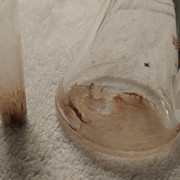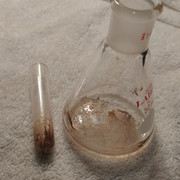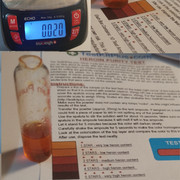Dimethyl ether is gaseous at room temperature, BP below -20, not hugely below, but at the very least your going to need efficient cooling, either a dry ice-acetone bath for convenience, or chaining progressively more efficient freezing mixtures, it does have one thing going for it-it doesn't tend to peroxidize, and also, its quick to strip, but unless you are tooled up to handle it, to keep it cold then it'll boil and evaporate right in front of your eyes. Diethyl ether would be more tractable, although, if you intend to store it, make sure that you test it regularly for peroxidation, and if you produce your own via either williamson synthesis or using sulfuric acid to dehydrate ethanol, then some BHT (butylated hydroxytoluene) or BHA (butylated hydroxyanisole) should be added, only a little is needed, to help inhibit peroxide formation.
Many ethers, diethyl ether included, have a nasty tendency to forming a corresponding hydroperoxide, itself reportedly deflagrating rather than detonating, but this then reacts further to form the alkylidene peroxide, and these are nasty customers, shock-sensitive, friction-sensitive, and on occasion, in seriously peroxidized ether, just going off for the hell of it. It'd be wise to do a little reading about how to handle and store ethers safely, and maybe a few nightmare scenarios to familiarize yourself with both best practice in general use, and how things go wrong, when they go wrong and what can happen when the shit hits the fan, or, if something does go tits up peroxide-wise and you end up with a fridge blown through the ceiling...(not trying to scare you off, its just one that sticks in my mind, not personal experience, but goes to show, a bottle of badly peroxidized ether is a bomb waiting to happen, and one thing to keep in mind, is if EVER a bottle develops any visible crusting around the top, don't even touch it, call the bomb squad. At least, if you prefer a potential bollocking to getting blown to pieces. )
That said, ethers can be reasonably, safely and responsibly used by people without formal chemistry training. Just look up the various methods of inhibiting peroxidation, and be aware that peroxide test strips can be made by soaking potato starch or starch spray into paper, along with a solution of potassium or sodium iodide. A sample of ether should be regularly tested, a few drops onto such a strip, and the oxidizing nature of peroxides lends itself to liberating iodine, if present, which then undergoes the characteristic blue-black colour change. The more deep the colour, the worse peroxidation is, if it is a problem in a given sample, the ether should be treated to destroy the peroxide. Storage over something like one of the more reactive alkaline earth metals, calcium would be a good choice IMO due to its non-pyrophoric nature, as granules/chips would suffice although there are a few ways of doing it.
Personally, I like to 'top off' bottles of peroxidation-prone solvents like diethyl ether, THF, diisopropyl ether etc. with argon, and ideally sparge the lot whenever I get it to drive off any dissolved oxygen, and fill container headspace with inert gas. Be mindful if you were to find lithium the only available highly reactive metal (Na is frequently used) that if you were to take it out of batteries, there can be be other components in there which are oxidizing, such as MnO2 in Li metal batteries, that wouldn't make ideal additions (its cheap as pellets on ebay, clean, or in somewhat thin strips for example, which have a rapid (in air) but quite controllable, 'tame' alkali metal, if you've never handled sodium, potassium before, Li doesn't have nearly the tendency towards pyrophoric behaviour, especially in thin or small amounts, which can easily oxidize before having the change to burst into flames.
Sodium on the other hand, its a bit more lively (especially when chucked into water, yes, yes, I know, but find me a hobby chemist who hasn't had fun with Na in water), and K has teeth, so IMO Li makes the ideal candidate, as does Ca, in that they are less likely to bite the less experienced chemist in the ass, especially when you take into account the flammability and volatility of ether (another thing to take into account, is any stirrer or heating method used needs to have sparkless motors, or at least, a copper mesh attached to the air intakes to serve as a fire arrester. Some switches can spark when the pole is flipped, and with volatile solvents around, it never pays to think 'oh it won't happen'
Because as they say, 'shit happens'. Bad days in the lab happen, I've had a few myself, and all one can do is take the appropriate precautions.
If your using ether for availability reasons, can I reccomend dichloromethane instead? it, and chloroform, are excellent solvents for morphinan opioids, in their freebase forms. Aqueous ammonia makes a good base, not too harsh and not overly prone to cleaving esters such as heroin, which are a somewhat labile functional group, sensitive to excessively acidic or basic conditions.
DCM is preferable, of the two, IMO, due to its lower boiling point, and being more convenient to strip. Its nonflammable, but something important to remember about halogenated solvents is NEVER allow them to end up being pyrolyzed, such as by smoking, as they don't tend to catch fire, but if they are forcibly passed through sufficient heat to decompose them, phosgene is a common byproduct. And if phosgene scares the living crap out of you, whilst ether shouldn't, phosgene should.









